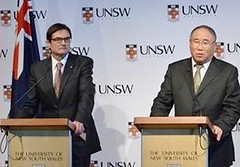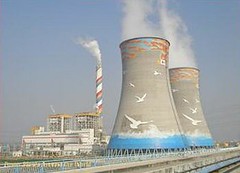 澳洲和中國官方3月27日宣布合作開發兩國的碳交易市場,為未來的亞太碳市場鋪路。
澳洲和中國官方3月27日宣布合作開發兩國的碳交易市場,為未來的亞太碳市場鋪路。
在雪梨召開的澳中氣候變遷部長對話(Australia-China Ministerial Dialogue on Climate Change)上,澳洲氣候變遷部長康貝特(Greg Combet)和中國國家發展與改革委員會(以下簡稱中國國家發改委)副主委解振華共同發表此聲明。
中國是世界最大的碳排放國,而澳洲是全球已開發國家中人均碳排放量最高的國家。兩國將合作,減少因燃燒煤、石油和天然氣產生的溫室氣體排放量。
中國預計在2015年後實施碳排放權交易制。澳洲則已訂定碳價格,將在2015年轉移至碳排放權交易制。
兩國官方的年度交流還包括於新南威爾斯大學召開的澳洲中國氣候變遷論壇(Australia China Climate Change Forum)。
「氣候變遷是人口、國家和全世界的潛在威脅,」康貝特表示「澳洲對於中國因應氣候變遷的計劃有高度興趣。原因很簡單;沒有中國的支持,我們無法解決氣候變遷帶來的問題。」
「中國的碳排放量佔全球的三分之一,是全世界最大的能源消耗國和全世界第二大的經濟體。」
康貝特也指出「中國以驚人的速度往低碳之路邁進。2005年,中國幾乎沒有任何再生能源工業,但是現在其風力、太陽能和水力發電技術已經引領全球。」
解振華認為,說中國這個全世界最大的污染源和世界第二大經濟體沒有致力於減少碳排放量,是對中國的誤解。
中國國家發改委氣候變化司資深官員蔣兆理博士提出警告,如果中國再不想辦法解決碳排放和汙染問題,中國的人民和自然環境都將會面臨難以想像的嚴重後果。
過去兩年,澳洲和中國密切合作規劃其試點和全國的碳排放交易機制。
兩周前,中國首次公布詳細的全國碳交易機制執行計劃。「解副主委所提出的中國國家碳市場計劃非常詳盡,將是全球碳交易市場的重大發展」康貝特表示,「一旦開始執行,也將會是全球規模最大的碳交易市場。」
中國預計在2015年完成全國碳排放交易系統。碳交易制度將會在湖南和廣東兩省以及北京、重慶、上海、深圳和天津五大城市進行初次的試點。這些地區皆有相當高的能源消耗和碳排放量。
這七個地區總人口數高達2億5千萬,約是澳洲總人口數的10倍,碳排放量總和則是全澳洲的兩倍。
 廣東省的全年碳排放量和澳洲的全年碳排放量不相上下。首次在此進行的試點將會涵蓋該省總能源消耗的40%,以及鋼鐵和製造等工業用能源的三分之二。
廣東省的全年碳排放量和澳洲的全年碳排放量不相上下。首次在此進行的試點將會涵蓋該省總能源消耗的40%,以及鋼鐵和製造等工業用能源的三分之二。
澳洲的碳交易計劃將運用在一年碳排放量超過2萬5千噸碳的企業,而北京的起徵點為1萬噸。
因此,北京試點計劃將會囊括600間公司企業,包括電力公司、鋼鐵製造公司、橡膠廠和石化工廠。
「中國密切地關注澳洲的碳交易制度,其乾淨能源計劃也反映了中國未來的政策走向。中國對各國碳交易機制的積極瞭解和交流,顯示氣候變遷的國際合作正在日漸成長,有助建立穩固的國際碳市場。」康貝特指出,「我們對亞太碳交易市場的發展有共識,這個市場已經開始成形。」
加州、紐西蘭、日本東京和琦玉縣已實施碳排放交易制度。南韓則會在2015年開始施行碳交易。
澳州和紐西蘭政府已於2011年12月宣布合併兩國的碳交易機制。
新南威爾斯大學能源和環境市場中心(Centre for Energy and Environmental Markets)將會和中國七個試點地區的專家學者合作,共同研究試點計劃的設計、執行和營運面,以及其他有助減少碳排放的議題。
新南威爾斯大學能源和環境市場中心主任 Iain McGill副教授表示「中國即將成為全球最大的碳價格體系。若在中國的七個試點計劃能夠成功,將會是中國乃至全世界減少全球暖化效應的一大步。」
Australia and China are working in concert to develop their individual carbon trading markets as a first step towards a broader Asia-Pacific carbon market, officials from both countries announced today.
The announcement came at the Australia-China Ministerial Dialogue on Climate Change in Sydney, led by Greg Combet, the Australian minister for climate change, industry and innovation, and Xie Zhenhua, the vice chairman of China's National Development and Reform Commission.
China is the world's largest carbon emitter while Australia is the world's highest per-capita carbon emitter among developed nations. The two countries are cooperating in an attempt to limit emissions of the heat-trapping greenhouse gas carbon dioxide that arise from the burning of coal, oil and gas.
China aims to move to a national emissions trading scheme after 2015. Australia has set a carbon price that will transition to an emissions trading scheme in 2015.
As part of their annual dialogue, both officials took part in the Australia China Climate Change Forum at the University of New South Wales.
"Climate change is looming as the pre-eminent threat to populations, nations and the world community," Combet said. "There is strong interest in Australia in what China is doing to address climate change. The reason for this is straightforward. Without China, we cannot solve climate change."
"Almost one third of global emissions come from China alone," Combet said. "It's the world's largest energy consumer and is the second largest economy."
Combet said, "China is moving towards a low-carbon path at an astonishing pace. In 2005, China had next to no renewable industry. It now leads the world in wind, solar and hydro power."
Xie challenged the "misunderstanding" that China – the world's biggest polluter and second largest economy – was failing to act on carbon emissions.
A senior official from China's Department of Climate Change, Dr. Jiang Zhaoli, told the conference China would face a "horrific" future with unimaginable consequences for its people and its natural environment if it did not act decisively now to curb climate pollution.
Over the past two years Australia has been working closely with China on the development of its pilot and national emissions trading schemes.
Two weeks ago, for the first time, China made public its detailed plan to implement a nationwide emissions trading scheme.
"China's national carbon market plans, which Vice Chairman Xie outlined this morning, are comprehensive and will be a very important development for the global carbon market," Combet said. "Once up and running, it will be the largest emissions trading scheme in the world."
China has decided to establish a national carbon emission trading system by 2015.
As a first step, carbon-trading pilots have been initiated in two provinces – Hunan and Guangdong – and five of China's largest cities – Beijing, Chongqing, Shanghai, Shenzhen and Tianjin – all with high energy consumption and high emissions.
The seven pilot cities and provinces have a total population of around 250 million people – about 10 times Australia's population – with roughly twice the carbon emissions covered by Australia's system.
Guangdong's annual carbon emissions are almost as high as those of all Australia. Guangdong's pilot will cover over 40 percent of the province's total power consumption, and around two-thirds of its industrial energy use including steel, iron and manufacturing.
Australia's emission trading program applies to businesses which emit more than 25,000 tonnes of carbon pollution a year, while the thresholds in the Beijing pilot will be only 10,000 tonnes.
As a result, Beijing's pilot scheme will cover some 600 companies, including electricity generation companies, steel producers, rubber plants and petrochemical factories.
Combet said China is closely monitoring the implementation of Australia's emissions trading scheme and its Clean Energy Future package to inform the development of Chinese policy.
"China's openness to the possibility of linking with other emissions trading schemes around the world is further evidence of growing international cooperation on climate change," Combet said. "It will build further momentum towards establishing a robust international carbon market."
"We both share a vision for the development of an Asia-Pacific carbon market," Combet said. "This market is already starting to emerge."
California, New Zealand and the Japanese cities of Tokyo and Saitama already have emissions trading schemes in place. South Korea will start its carbon trading market in 2015.
The Australian and New Zealand governments announced plans to link the two countries' emissions trading schemes back in December 2011.
University of New South Wales' Centre for Energy and Environmental Markets will work with Chinese researchers in several of the seven regions identified for pilot carbon trading markets, including Beijing and Shanghai, to study the design, implementation and operation of the pilot schemes plus other key issues for successful emissions reductions.
The Centre's Joint Director Associate Professor Iain McGill, "China is now poised to become one of the world's largest jurisdictions with carbon pricing in place. Successful development of a national scheme from their seven pilots can play a vital role in China's, and hence the world's, efforts to slow global warming and its impact."
※ 全文及圖片詳見:ENS



